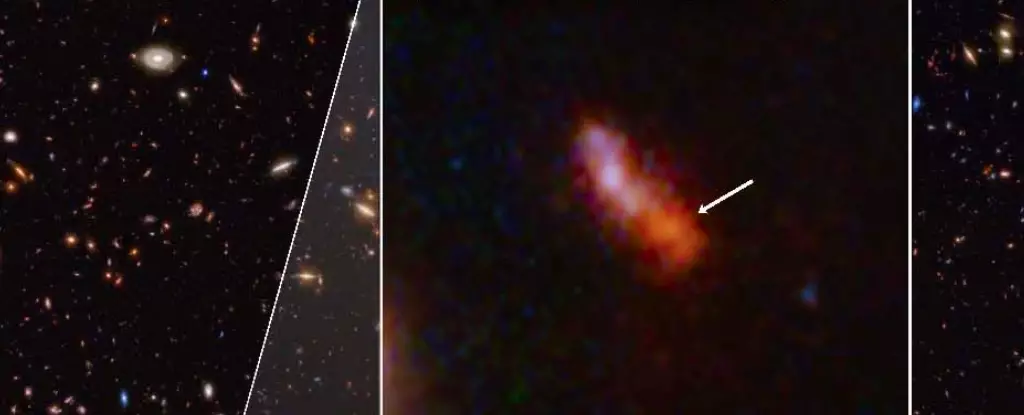The James Webb Space Telescope (JWST) is rewriting our understanding of the cosmos, having recently located a galaxy that existed a mere 280 million years after the Big Bang—dubbed MoM-z14. This groundbreaking discovery is not just a feather in the cap for the observational capabilities of JWST; it is a monumental leap in our quest to comprehend the formation and evolution of galaxies. Prior to the JWST, instruments like the Hubble Space Telescope and the Spitzer Space Telescope were limited, unable to capture the intricate light signatures of early galaxies due to their smaller mirrors. The JWST, with its state-of-the-art infrared capabilities and expansive mirror, is bridging the gaps of both time and space while providing insights that were once deemed unfathomable.
A Revolutionary Observational Frontier
Historically, astronomers relied on the Hubble in near-infrared to glimpse the earliest moments of our universe. Hubble’s 2.4-meter mirror and the Spitzer’s even smaller 85 cm diameter were inadequate for fortune-hunting in the depths of time. Enter the JWST, boasting a whopping 6.5-meter mirror and advanced detector technology capable of penetrating cosmic veils. Through this powerful lens, the JWST has captured light from galaxies at redshifts greater than z=10 within just weeks of starting observations. The implications of this achievement stretch beyond mere fascination; it challenges existing paradigms and ignites intense dialogue surrounding galaxy formation during one of the universe’s infancy stages.
As researchers involved in the “COSMIC MIRACLE” study detail, the galaxy MoM-z14 exemplifies an unexpected population of luminous celestial bodies that defy previous expectations of what kinds of galaxies might have existed in the early universe. This jarring revelation has incited discussions that probe the very foundations of galactic formation theory. The detection of galaxies so far removed in time compels astrophysicists to reevaluate their approximations and assumptions about cosmic evolution.
Illuminating Chemistry and Evolution
Moreover, the spectroscopic analysis of MoM-z14 has yielded unprecedented insights into the galaxy’s chemical composition. Notably, the galaxy displays a nitrogen-to-carbon ratio higher than that found in our Sun. This intriguing detail not only reinforces existing theories about early stellar environments but also suggests that the stars in MoM-z14 formed under conditions reminiscent of ancient globular clusters. These new breed galaxies appear to be rewriting our understanding of chemistry in the infancy of cosmic time.
The research points to distinct morphological traits—point-like versus extended sources—appearing in these ancient bright galaxies. This could signify a profound connection between morphology and chemical makeup, suggesting that the universe’s structure is far more complex than a linear progression of galactic evolution. The correlation between specific traits and the chemical composition opens avenues for scientific inquiry that could unveil layers of cosmic history yet unexamined.
Connecting Ancient Stars to Modern Discoveries
The JWST’s observations are more than a catalog of early galaxies; they forge links across cosmic time scales. The notion that the characteristics of the newly discovered galaxies relate to the formation of the Milky Way’s oldest stars enables researchers to contemplate how the early universe laid the groundwork for present-day cosmic configurations. As scientists assess the luminosity and nitrogen emissions of these distant galaxies, they focus on the understanding of conditions and events that contributed to the modern universe.
MoM-z14 nd other nitrogen-rich objects signify a bimodality in compositions, implicating a noteworthy size-chemistry relationship at redshifts greater than z=10. This kind of granular revelation reminds astronomers that the early universe was filled with surprises and mysteries yet to be fully understood. It hints at shimmering possibilities, suggesting that our limits in understanding are not as concrete as we presumed.
Looking Ahead: Future Cosmic Explorations
The anticipation surrounding the Roman Space Telescope, with its potential to uncover hundreds more galaxies akin to MoM-z14, elicits a sense of excitement in the astrophysics community. Should this next-generation instrument validate the unexpected findings of the JWST, it may cement our current understandings or possibly unveil further mysteries that challenge our grasp of cosmic history.
The discovery of MoM-z14 is but a spark within the expansive fireworks display of what JWST is capable of revealing. As we inch closer to cosmic epochs marked by the very first stars, every breakthrough compounds the excitement. It is a bold new frontier driven by curiosity, innovation, and an unrelenting desire to connect the past to the present. The JWST is leading the charge, and if this current trajectory is any indication, we are set to embark on an exhilarating journey through the skies of our ancient universe.

